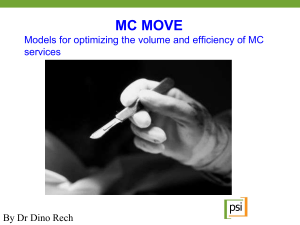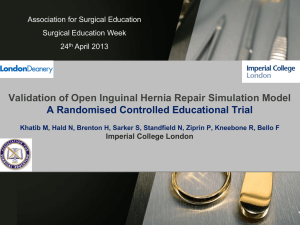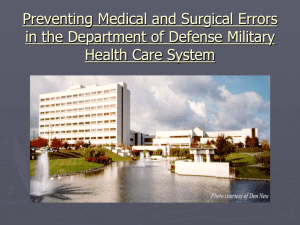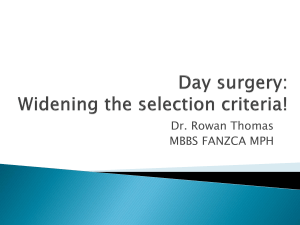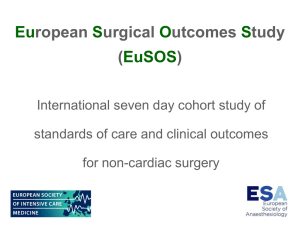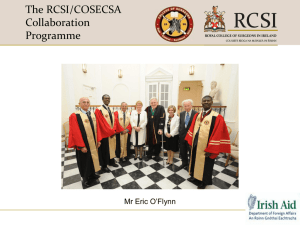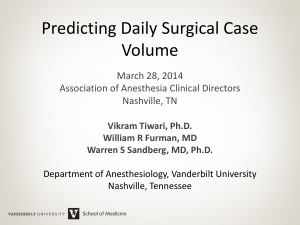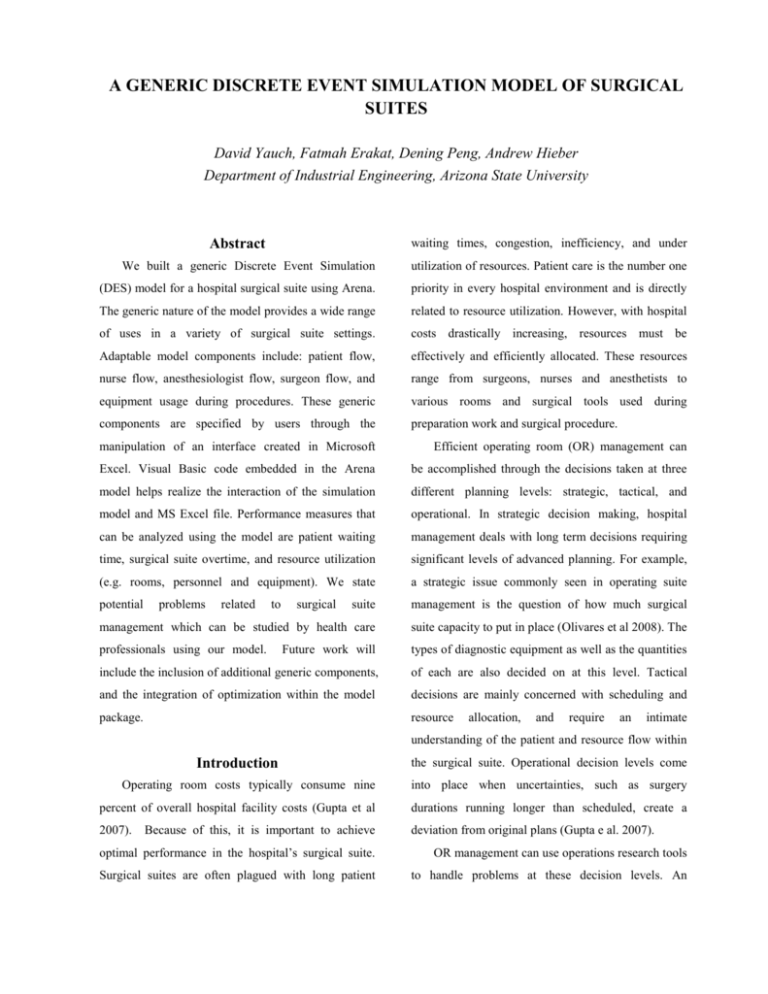
A GENERIC DISCRETE EVENT SIMULATION MODEL OF SURGICAL
SUITES
David Yauch, Fatmah Erakat, Dening Peng, Andrew Hieber
Department of Industrial Engineering, Arizona State University
Abstract
waiting times, congestion, inefficiency, and under
We built a generic Discrete Event Simulation
utilization of resources. Patient care is the number one
(DES) model for a hospital surgical suite using Arena.
priority in every hospital environment and is directly
The generic nature of the model provides a wide range
related to resource utilization. However, with hospital
of uses in a variety of surgical suite settings.
costs drastically increasing, resources must be
Adaptable model components include: patient flow,
effectively and efficiently allocated. These resources
nurse flow, anesthesiologist flow, surgeon flow, and
range from surgeons, nurses and anesthetists to
equipment usage during procedures. These generic
various rooms and surgical tools used during
components are specified by users through the
preparation work and surgical procedure.
manipulation of an interface created in Microsoft
Efficient operating room (OR) management can
Excel. Visual Basic code embedded in the Arena
be accomplished through the decisions taken at three
model helps realize the interaction of the simulation
different planning levels: strategic, tactical, and
model and MS Excel file. Performance measures that
operational. In strategic decision making, hospital
can be analyzed using the model are patient waiting
management deals with long term decisions requiring
time, surgical suite overtime, and resource utilization
significant levels of advanced planning. For example,
(e.g. rooms, personnel and equipment). We state
a strategic issue commonly seen in operating suite
potential
suite
management is the question of how much surgical
management which can be studied by health care
suite capacity to put in place (Olivares et al 2008). The
professionals using our model.
Future work will
types of diagnostic equipment as well as the quantities
include the inclusion of additional generic components,
of each are also decided on at this level. Tactical
and the integration of optimization within the model
decisions are mainly concerned with scheduling and
package.
resource
problems
related
to
surgical
allocation,
and
require
an
intimate
understanding of the patient and resource flow within
Introduction
the surgical suite. Operational decision levels come
Operating room costs typically consume nine
into place when uncertainties, such as surgery
percent of overall hospital facility costs (Gupta et al
durations running longer than scheduled, create a
2007).
deviation from original plans (Gupta e al. 2007).
Because of this, it is important to achieve
optimal performance in the hospital’s surgical suite.
OR management can use operations research tools
Surgical suites are often plagued with long patient
to handle problems at these decision levels. An
important operations research technique used for
In this study, we create a discrete event simulation
evaluation of the solutions is simulation. Simulation is
(DES) model using ARENA 12.0 to analyze the
a common tool for OR managers since it incorporates
patient flow and processes that take place within a
randomness in systems and allows us to analyze
surgical suite. Our model is a generic model of a
multiple alternatives for a system design. Furthermore,
surgical suite in a hospital and will be available for use
risk is minimized because changes can be simulated
by surgical suite managers. This model enables OR
without making changes to the actual surgical
managers to create various patient and resource flows
processes.
to analyze multiple alternatives.
Processes in surgical suites that can be analyzed
Literature Review
by OR managers are patient check-in and intake, the
procedure itself, and patient recovery. Within each
The following is a brief literature review that
process, particular types of resources are needed
summarizes several different examples from the
during different stages; therefore, the processes
literature related to our work. We focus on studies that
themselves can be broken down even further. For
use DES models either to examine the re-allocation of
example, the surgery time is split into three different
hospital resources or the impact of different scheduling
sections: pre-incision, incision and post-incision.
approaches to improve efficiency throughout the
Potential performance measures that can be
system.
analyzed are resource utilization, patient waiting
Dexter et al (2001) investigates the affect of an
times, surgical suite overtime, and the number of
increase in utilization rates for a surgical suite on
surgical delays due to resource availability.
revenue. The model implements the surgical suite block
Some examples for the potential managerial
scheduling of thousands of cases while considering the
problems that can be analyzed using discrete event
utilization rates of the surgical suites as the main
simulation (DES) model are:
performance measures. The authors conclude that the
Analysis of the patient flow through surgical
suites;
volume is increased for longer case durations. Baumgart
Analysis of the impact of changes in surgery
scheduling procedure;
surgery schedule;
different
et al (2007) emphasizes the importance of efficiency of
surgical suites and shows the benefit of using simulation
Examining the affect of surgery delays on the
Evaluating
utilization rates increase in a small amount when patient
to optimize the use of resources to minimize costs. The
simulation analyzes the overall workflow within the
surgery
scheduling
alternatives;
Investigating the effect of altering the level of
resources available;
Comparing various flows including nurse,
anesthetist, patient, and surgeon flows.
surgical suite at a major hospital and shows how the
different number of anesthesiologists and ordering times
affect the resource utilization. The study mainly reveals
the inverse relationship between the utilization rates of
the general surgeon and the anesthesiologist. Cardeon et
al (2008) uses DES to simultaneously evaluate the
efficiency of clinical pathways against resource
utilization and patient throughput a generic model of the
additional surgery. The two parameters varied in the
patient flow was created and analyzed and the clinical
study are mean case duration for performed cases and
pathway guidelines were considered. The authors
the number of operating rooms in the suite. They first
conclude that with the current set of clinical pathways,
schedule surgery cases until there is no slot available to
the number of procedures performed is almost
schedule another one. Next, they cut down the case
equivalent to the number of time slots available in the
durations in order to schedule an additional case. The
day. Also, the human resources must perform overtime
study shows that decreasing durations for all cases is
in order to complete the procedures. The results
possible but may not permit an additional case,
conclude that some patients make seek out other sources
regardless of the number of resources available. Dexter
of medical assistance. Marjamaa et al. (2007) also uses
et al (2009) evaluates operating room data to see if an
discrete event simulation to evaluate the optimal use of
additional turnover team is necessary to decrease
resources and examine the cost-efficiency of each. The
turnover times, as well. Simulation is used to study the
main performance measures considered are the number
number of turnover teams that should be assigned. They
of human resources in the surgical suite, surgery time,
conclude that with a low number of turnover teams,
number of surgeries and staffing costs and it was
simultaneous turnovers are greater than the number of
concluded that scheduling surgeries of shorter length
turnover teams, when there is an increase of one in the
spate from longer ones had little effect on cost-
teams. Wullink et al (2007) discusses how reserved
efficiency. VanBerkel et al (2007) uses simulation to
operating room capacity is used to maximize the
model the general surgery division in order to answer
responsiveness to an emergency patient. The simulation
planning questions regarding the unbalance of supply
model helps determine the best way to preserve the
and demand of resources and concluded that a decrease
surgical suites times in need for an emergency surgery.
in number of beds carried a negative effect on elective
The two approaches that the authors analyze include:
patient throughput. Finally, Van Oostrum (et al 2008)
dedicating all reserved surgical suites capacity to
creates a simulation model to determine the optimal
emergency situations and reserving capacity uniformly
number of resources during the night in preparation for
throughout elective surgical suites. They consider
emergency cases. The performance measures studied
patient waiting times, surgical suites utilization rates
are the amount of surgical suites and post-anesthetic
and staff overtime as the performance measures of the
nurses called in and the number of violations of safety
study. The authors conclude that surgical suites can be
intervals towards the patient took place. The authors
more flexible when evenly allocating the non-urgent
examine the effects of reducing the number of nurses in
surgeries and thus show how a better quality of staff
the ward on patient treatment. Furthermore, they
satisfaction, cost-effectiveness, and patient care can be
indicate how patients can wait for a short period of time
achieved. Wright et al. (1987) created a simulation
for surgery without violating any of the safety
model to estimate the effects of bed reductions. The
guidelines.
performance measures are bed occupancy rates, number
Dexter et al (1999) analyzes how small decreases in
of admissions per bed, number of patients sent to
case durations may allow room to schedule an
alternate wards and number of rejected patients. The
simulation shows that a reduction in beds directly
means of improvement in the ICU. The process flow of
affects the number of rejected cases.
the model represented both the patients and the
Ferreira et al (2007) uses DES to analyze the
surgeons. They illustrate the necessity of taking into
impact of increases in the amount of resources and
consideration functional ICU capacity when analyzing
changes in scheduling, at a surgical suite in a major
ICU bed requirements related to surgical procedures.
hospital. The model examines the allocation of post-
The main performance measures are the number of
anesthetic beds (PABs) and increase in surgery
patients that require ICU stay, average number of
numbers. The performance measures analyzed are the
patients that did not stay in ICU, even though
number of surgeries performed per day, surgical rooms’
recommended; and utilization rates of the ICU beds.
use and blocking rate; patient blocking rate, delay in
The authors conclude that waiting times for the requests
surgeries, and the number of postponed surgeries. The
of these beds for patients that require an ICU stay is
authors conclude that a significant improvement can be
much longer than if there were an unlimited number of
attained in productivity through flexible scheduling and
the beds. Patient waiting was used as a method of
an increase of the PABs. Vasilakis et al. (2007)
identifying the functional ICU capacity within the
however, built a simulation model to analyze the impact
hospital.
of scheduling on the number of patients waiting. The
statistical methods used to analyze the cancellation rates
authors outline operational processes that comprise the
of elective surgeries using a simulation model and
care in surgical suites and represent three patient
conclude that the statistical method should not be used
pathways. The performance measures of the study are
due to the high error rates of the calculations.
Dexter et al. (2005) study the strength of
the overall number of non-appointment patients waiting
Our work differs from the previous studies in the
times and the times between referral of surgery to
following aspects. First, our simulation model is not
appointment and appointment to the surgery itself. The
based on a specific operating suite. The user is given
authors conclude that reducing patient waiting times
the ability to match the model to a specific suite by
comes through scheduling on a first available basis.
manipulating the Excel interface. Second, the inclusion
While Marcon et al. (2006) analyzes the impact of
of several patient and resource flows allows the
sequencing rules on the post-anesthetic care unit
evaluation of multiple alternatives without having to
(PACU) staffing and over-utilized operating room
modify the Arena model, which allows its use by
times. The three rules mentioned in the study are
managers without technical knowledge of Arena.
shortest-cases first, longest cases first and a random
Finally, our model reports a comprehensive set of
sequence of both. The authors aim to schedule cases
performance measures for the user to consider, allowing
optimally and align the time of PACU nurses with
analysis of various system alternatives based on the
demand so that they can reduce the length of stay and
users’ preference.
also reduce the staffing requirements for the PACU.
Troy et al. (2009) uses a DES model to precisely
Simulation Model
analyze the processes, timing and arrival of ICU
Our DES model features patients traversing a
patients. The general goal of the study is to identify
surgical suite while receiving treatment and utilizing
resources along the way. The flow of the patient, the
addition, minimizing patient waiting time is important
timing of the resource utilization, and the type of
in the prevention of sepsis.
resources seized are all set by the user through the
selection of several alternatives.
Resource utilization is defined as the amount of
160 different
time that a specific resource (e.g. intake rooms, nurses,
resource and patient flow configurations are possible
equipment) is in use divided by the amount of time the
through the manipulation of the user interface.
surgical suite is available.
Furthermore, the user interface allows the user to set
the capacity of every resource used in the model, and
Generic Modeling Components
to determine, based on the type of surgery, whether or
First, the model is made more generic by allowing
not to seize any combination of five different pieces of
the user to choose between two types of patient flows:
generic equipment. The user interface was created in
linear or re-entrant. In both flows, the patient is first
Microsoft Excel to allow a user with no technical
taken to an intake room, followed by the operating
knowledge of Arena to modify the model settings.
room. In the linear flow, the patient then recovers in a
Visual Basic for Applications (VBA) code was
recovery room, whereas the re-entrant flow requires
embedded within Arena to allow Arena to accept
the patient to recover in the same type of room used
resource capacities and the simulation start date/time
for intake.
from Excel. To gather the model parameters and
Second, we have included several possible nurse
surgery schedule from Excel, Arena’s Read/Write
flows to enable this model to capture a wide variety of
nodes were used.
nurse utilization strategies. In our model, there are five
The model is a terminating
simulation (Banks et al. 2005), where the system
operates daily for a pre-determined length of time and
different strategies available:
The first option will instruct the model to never
seize any nurses of any type, regardless of whether or
various procedures occur during the scheduled time.
not the capacity of this resource has been defined. This
Performance Measurements
The model will measure average patient waiting
is equivalent to ignoring nurses in the simulation. We
time, surgical suite overtime, resource utilization (e.g.
include this part because there may be situations
operating room utilization), and the
number of
where nurses are assumed to be plentiful, and because
surgical delays due to resource unavailability, which
it allows the user to analyze the effect of nurses on the
results from uncertainties such as unexpected long
system by removing the nursing constraint from the
patient treatment times.
model.
Patient waiting time is defined as the total amount
In the second type of nurse flow, one nurse is
of time that patients wait for the preoperative,
assigned to the patient from the time they enter the
postoperative rooms and operating rooms to be
intake room until the time that they finish recovery.
available for their surgery. Minimization of this
This scenario may be encountered when nurses with
variable is a common goal in surgical suite simulation,
specialized knowledge are needed to care for specific
and is directly related to patient satisfaction.
types of patients.
In
In the third type of nurse flow, an intake nurse
process, depending on the policy of the individual
takes care of the patient during intake, a surgical nurse
health care setting. The anesthesiologist can be seized
takes care of the patient during surgery, and a recovery
before intake, or before pre-incision, but cannot be
nurse takes care of the patient during recovery. Each
seized afterwards since it is assumed that anesthesia is
type of nurse is seized before the patient begins the
completed before incision begins.
procedure in their respective areas, and is released
released after post-incision or after recovery, depending
when that procedure is completed.
on who is assigned to monitor the recovery of patients
In the fourth type of nurse flow, the same type of
They may be
in the surgical suite to be analyzed.
nurse takes care of the intake and recovery of a given
The surgeon and anesthesia flows were modeled as
patient, while a surgical nurse cares for the patient
attributes of individual patient entities in Arena. The
during the surgical process. This type of nurse flow
corresponding attributes are read from the excel file
mirrors the re-entrant patient flow: intake/recovery
individually for each patient, allowing the user to assign
resources are combined to provide greater equality in
different flows to each patient based on their procedure
resource utilization throughout the day.
type. This allows the user to consider that the surgeon
In the fifth type of nurse flow, all nurses are
and anesthesiologist may not be required for as much of
assumed to be capable of performing duties in any
the surgery process during minor surgeries as they
area (intake, procedure, recovery). A nurse is seized
would during a major procedure.
at the beginning of each process, and released at the
In addition to the model alternatives listed
end of that process. This allows nurses to “float” to all
previously, our model also allows the user to specify
areas of the surgical suite.
the capacity of different resources. In addition to the
The various nursing flows were implemented
standard resources such as nurses, surgeons, and
in Arena using decision nodes at critical points. The
anesthesiologists, there are five generic kinds of
decision nodes route the patient entities in different
equipment in this simulation model. The user may
directions based on the nurse flow setting in the user
dictate which combination of equipment is needed for
interface.
which procedures, and may dictate the capacities of
Based on the fact that anesthesiologists and
each equipment type as well. Different types of
surgeons in surgical suites may start and end their work
patients may require different combinations of
at different steps of the patient flow, anesthesiologists
equipment during their treatments (e.g. monitors and
and surgeon flows are also added in the model and can
diagnostic equipment). The generic equipment is
be specified through the user interface. The user is given
implemented in Arena using decision nodes which
the option of when to seize and release the surgeon and
instruct each patient entity to seize and release only
anesthesiologist.
The surgeon may be seized before
the required equipment for that entity. By setting the
pre-incision or before incision, but may not be seized
equipment requirements to zero, the user may ignore
after incision because it is assumed that they must be
equipment requirements in their model.
present for the incision. They may be released after the
As mentioned previously, the user may set the
incision part of the surgery, or after the post-incision
resource capacities of every resource in the model,
including rooms, personnel, and equipment.
The
model could easily be modified to allow the user to set
are seized for the explicit purpose of transporting
patients from one area of the hospital to another.
a calendar schedule for each resource’s capacity, but
Conclusion
this functionality was not included in this model due
to time constraints. Users may choose to selectively
This paper presents a generic discrete event
ignore individual resources by giving them a very
simulation model of operating rooms and shows how
large capacity or, in certain scenarios, by setting the
this model can be adjusted to model various types of
model not to seize the resource in the first place.
surgical suites. Users may set the time that certain
resources should be seized as well as the amount of
Model Assumptions
resources available and the type of resource and
Due to the inherent complexities in trying to
patient flows through the model. Various performance
accommodate a wide range of surgical suites, multiple
measures are collected for users to measure the
assumptions were derived during the completion of
performance of the simulated system, helping them
the DES model.
We assume that the five generic
gain insights into system performance. Changes in
equipment resources added to the model are used
these measures can be monitored as the model is
solely during surgery and are not moved out of the
adapted in order to analyze alternative surgical suite
surgical suite. Also, all required equipment for a
configurations, and to better understand the effects of
patient who is currently in surgery is occupied during
different aspects of the surgical suite on overall
the entire duration of the surgery and cannot be used
performance.
by other patients. We do not consider the case where
Future work on this model can be performed in
equipment may travel from surgery to surgery before a
several areas. First, many more generic issues can be
patient has finished the procedure. Next, surgeons are
included in the model to allow it to accommodate
not required before the surgical process or when the
additional surgical suite configurations. For example,
patient has left the OR. It is assumed that the surgeon
we have assumed that all equipment is used during
will not meet with the patient for a significant length
surgery only and is used for the entire surgery.
of time during intake, and the surgeon does not
However in reality, that is not always the case.
actively tend to the patient during the recovery room
Therefore, the model can be made improved by letting
process. It is recognized that surgeons frequently visit
users choose when the equipment is seized and when
inpatients after surgery, but our model is only
it is released. Also, the current model focuses only on
concerned with interactions within the surgical suite.
simulation of the surgical suites, but there are
Anesthesiologists must be present during pre-incision,
upstream and downstream resources in hospitals that
but may be set to arrive sooner if desired. It is also
play a critical role in patient treatment, so extending
assumed that they may not leave before the patient
this model to include other departments in some
enters recovery.
capacity would be very meaningful.
Our final assumptions deal with
patient transportation. Our model assumes no nurses
Finally, the current model focuses on analysis of
the system as it has been inputted by the user. Future
models could include optimization routines that would
Operating Room Management: Impacts on Process
provide the user with suggested model parameters
Engineering and Performance. Proceedings of the 40th
based around certain fixed inputs.
Hawaii International Conference on System Sciences –
This concept
applies to the surgical schedule as well; the current
2007. IEEE Xplore. 1530-1655.
model can only run the schedule that is provided by
the user, but users may desire an automated method of
Cardoen, B. and Demeulemeester, E. Capacity of
applying various scheduling heuristics to the original
Clinical
schedule (see Gul et al. (2009) for some OR
Evaluation Tool. J Med Systems. 2008. 32: 443-452.
scheduling heuristics examples).
Pathways-
A
Strategic
Multi-Level
These changes
would greatly enhance the power and usefulness of the
Dexter, F. and Macario, A. Decrease in Case Duration
model by providing users with the tools necessary to
Required to Complete an Additional Case During
seek out better configurations, rather than attempting
Regularly Scheduled Hours in an Operating Room
to derive them by experimentation.
Suite: A Computer Simulation Study. Economics and
Health Systems Research. Peter G. Duncan. Anesthesia
Acknowledgements
Analog 1999; 88: 72-6.
The authors wish to thank the following individuals
Dexter, F., Marcon, E., Aker, J., Epstein, R. H.
for their contributions to this project:
Number of Simulataneous Turnovers Calculated from
Anesthesia
Serhat Gul, PhD Candidate in Industrial Engineering,
Arizona State University
or
Operating
Room
Information
Management System Data. International Anestheisa
Research Society 2009. 109 (3): 900-905.
Dr. John Fowler, Professor in Industrial Engineering,
Dexter, F., Epstein, R. H., Traub, R. D. and Xiao, Y.
Arizona State University
Todd Huschka, Master Health Systems Analyst in
Making Management Decisions on the Day of Surgery
Based on Operating Room Efficiency and Patient
Waiting Times. Anesthesiology 2004. American Society
Health Care Policy and Research, Mayo Clinic,
of Anesthesiologists, Inc. 101: 1444-53.
Minnesota
Dexter, F., Macario, A., and Lubarsky, D. A. The
References
Banks, J., J.S. Carson, B.L. Nelson, D.M. Nicol. 2005.
Discrete-event system simulation, 4th Ed., Upper Saddle
River, New Jersey: Pearson Prentice Hall.
Baumgart, A., Zoeller, A., Denz, C., Bender, H., Heinzl,
A. and Badreddin, E. Using Computer Simulation in
Impact on Revenue of Increasing Patient Volume at
Surgical Suites with Relatively High Operating Room
Utilization. Economics and Health Systems Research.
Anesthesia Analog 2001; 92: 1215-21.
Ferreira, R., Coelli, F., Pereira, W., Almeida, R.
Optimizing patient flow in a large hospital surgical
centre by means of discrete-event computer simulation
Troy, P. and Rosenberg, L. 2009. Using Simulation to
models. Journal of Evaluation in Clinical Practice.
determine the need for ICU beds for surgery patients.
Blackwell Publishing Ltd. 14(2008): 1031-1037
Surgery 146(4), 608-620.
Gupta, D. Surgical Suites’ Operations Management.
VanBerkel, P. and Blake, J. A comprehensive
Production and Operations Management. Vol. 16, No.
simulation for wait time reduction and capacity
6, 2007. 689-700.
planning applied in general surgery. Health Care
Manage Science. 2007. 10: 373-385.
Gul, S., Denton, B.T., Fowler, J.W., Huschka T. Bicriteria Scheduling of Surgical Services for an
Vasilakis, C., Sobolev, B. G., Kuramoto, L. and Levy,
Outpatient Procedure Center. Submitted to Production
A. R. A simulation study of scheduling clinic
and Operations Management.
appointments in surgical care: individual surgeon
versus pooled lists. Journal of the Operation Research
Huschka, T., Denton, B., Gul, S., Fowler, J. 2007. Bi-
Society. (2007) 58: 202-211.
Criteria evaluation of an outpatient surgery procedure
center via simulation. In: Henderson, S.G., Biller, B.,
Van Oostrum, J. M. A Simulation Model for
Hsieh, M.H., Shortle, J., Tew, J.D., Barton, R.R. (ed)
Determining the Optimal Size of Emergency Teams
Proceedings
on Call in the Operating Room at Night. Economics,
of
the
2007
Winter
Simulation
Conference, Piscataway, New Jersey: Institute of
Education and Policy. 2008. 107(5): 1655-1662.
Electrical and Electronics Engineers, Inc, 1510-1518.
Wright, M.B. The application of a surgical bed
Marcon, E. and Dexter, F. Impact of surgical
simulation model. European Journal of Operational
sequencing on post anesthesia care unit staffing. Health
Research 32 (1987) 26-32.
Care Manage Science (2006). 9: 87-98.
Wullink, G., Van Houdenhoven, M., Hans, E. W., Van
Marjamaa, R., Torkki, P., Hirvensalo, E. and Kirvela, O.
Oostrums, J. M., Van der Lans, M., and Kazemier, G.
What is the best workflow for an operating room? A
Closing
simulation study of five scenarios. Health Care Manag
Efficiency. J Med System (2007) 31: 543-546.
Emergency
Operating
Rooms
Improves
Science (2009) 12: 142-146.
Biographical Sketches
Olivares, M., Terwiesch, C. and Cassorla, L. Structural
David Yauch is a senior undergraduate student in the
Estimation of the Newsvendor Model: An Application
Department of Industrial Engineering at Arizona State
to Reserving Operating Room Time. Management
University (expected graduation date: December
Science. Vol. 54, No. 1, January 2008, pp. 41–55
2010).
His main interests include modeling and
optimization of health care delivery systems and
ergonomics. His e-mail address is: dyauch@asu.edu.
Fatmah Erakat is a senior undergraduate student in
statistics, process control, applied operations research,
Industrial Engineering at Arizona State University
and project management. Besides, he has a strong
with an expected graduation date of May 2010. Her
interest in the biological and health sciences as
primary interests include the application of OR
evidenced by his statistical research on how the
techniques for the improvement of healthcare systems
interconnections and interplay between different regions
efficiency. The bulk of her inspirations came after her
of the human brain influence Alzheimer’s symptoms.
Lean Work Design project at St. Joseph’s Medical
One of his goals would be to pursue the application of
Center in Phoenix, Arizona where she used OR tools
OR methods in a medical area such as genetics, tissue
to streamline the system. Recently, Fatmah has
generation, development of methods for the treatment of
enjoyed employing methods of simulation modeling to
disease, or the development of effective drugs at
the analysis of healthcare processes. She is planning to
pharmaceutical companies. His e-mail address is:
pursue a PhD degree at Arizona State University after
andrew.hieber@asu.edu
the completion of her undergraduate studies. Her email address is: Fatmah.Erakat@asu.edu.
Dening Peng is a senior undergraduate student in the
Department of Control Science and Engineering at
Huazhong University of Science and Technology in
China. He has been working towards his BS degree in
Industrial Engineering at Arizona State University
since August 2009. He is interested in supply chain
and health care delivery systems modeling and
optimization with a particular emphasis on the
application
of
stochastic
modeling
techniques,
simulation and scheduling algorithms. He is currently
conducting research on quantifying the relation
between lead time and product price in make-to-order
systems with the guidance of Dr. Esma Gel at Arizona
State
University.
His
email
address
is Dening.Peng@asu.edu.
Andrew Hieber is a senior undergraduate student in the
Department of Industrial Engineering at Arizona State
University (ASU) with the expected graduation date of
May 2010. He is also a pre-medicine student at ASU.
His primary interests include financial engineering,

